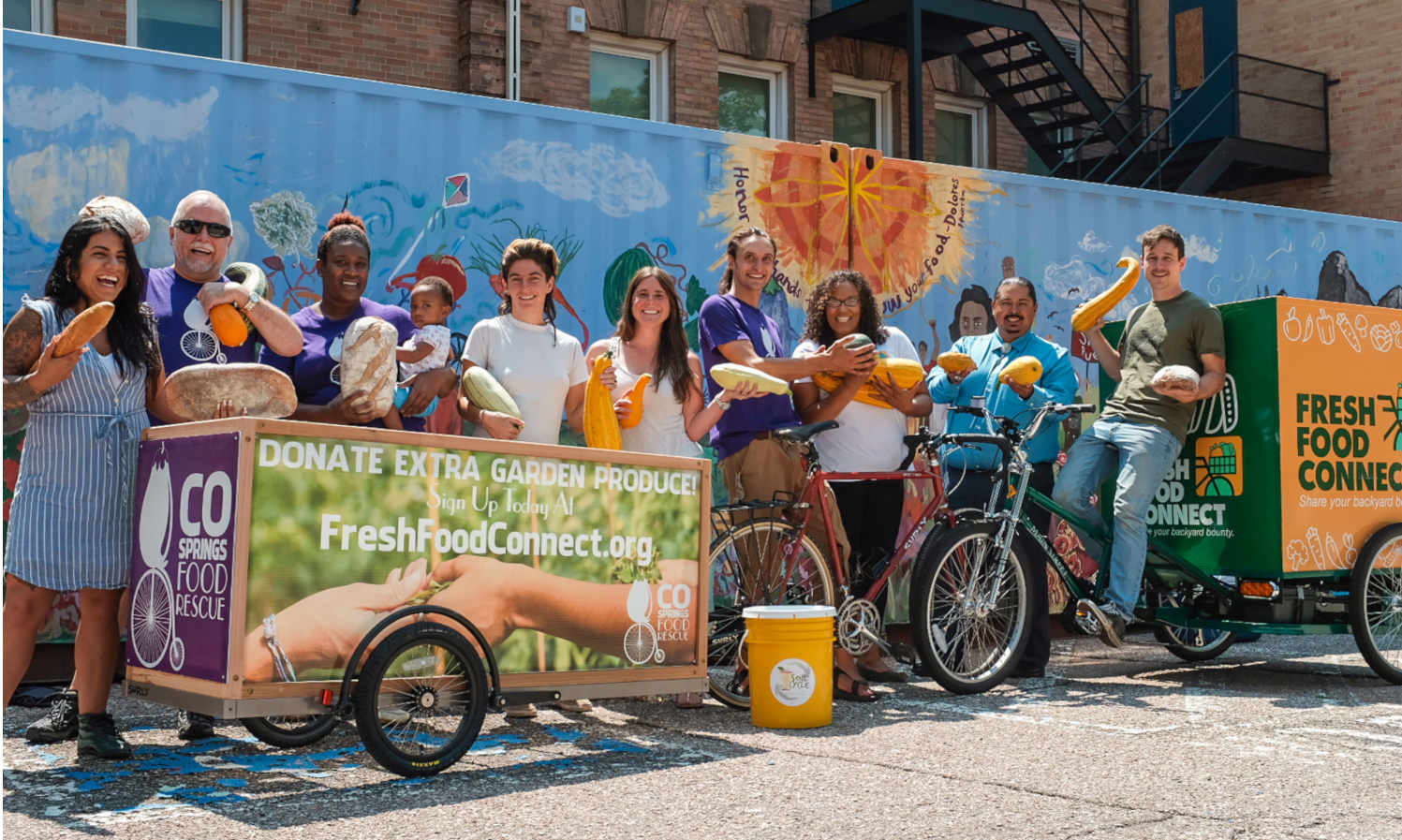Access to safe, affordable, and nutritious food continues to pose a challenge for many communities across Colorado Springs, CO. According to data from the United States Department of Agriculture (USDA), a relatively high number of residents live more than one mile from a supermarket in low-income and low-access census tracts. The Colorado Springs Food Rescue (CSFR) though, aims to tackle local food insecurity and neighborhood health inequity through a holistic food redistribution model.
The CSFR began in 2013 as a group of volunteers who used bicycles to gather food from donor businesses, redistributing it directly to local nonprofits. Now, CSFR offers an extensive program which operates across three main areas; food access, food production, and food education. “CSFR’s model minimizes transportation time; prioritizes the redistribution of healthy, perishable foods; and engages an expansive network of over 160 volunteers,” Executive Director Zac Chapman tells Food Tank.
The integrated program works across the local food system with initiatives such as No-Cost Groceries, a program which partners with food insecure neighborhoods to redistribute fresh surplus food. “CSFR has redistributed over US$5 million worth of nutritious groceries and created 8 no-cost grocery programs since starting, and served 13,000 unduplicated people in 2018 alone,” Chapman explains. To improve food access to all community members, CSFR also created The Farmacy, a program which connects local doctors and medicaid patients with healthy staples.
As 1 in 9 people struggle with hunger in Colorado, CSFR also places an emphasis on programs which target food production. Fresh Food Connect is a backyard garden and produce donation program with 59 gardeners, while Soil Cycle is a residential compost pick up service which currently has over 150 members.
To engage young community members, Colorado Springs Food Rescue facilitates food rescue and education programs at 12 schools. The Food Systems Leadership for Youth program helps students learn to manage a no-cost grocery program for over 2,000 underserved people. The CSFR has also partnered with academic and municipal institutions to conduct research and assess how to remove barriers to fresh food across Colorado.
CSFR is part of a collective of food rescue groups called the Food Rescue Alliance. Originally established by the Boulder Food Rescue, the Food Rescue Alliance provides a peer-to-peer learning network which supports the development of food redistribution models across the world. Currently, projects exist in Denver, CO; Jackson Hole, WY; Seattle, WA; Minneapolis, MN; and in the Philippines. “From the very beginning, the values of the Food Rescue Alliance were rooted in health equity, racial justice, and a critique on the perpetuation of emergency food assistance.” says Chapman.
In 2018, a study published in the American Journal of Preventive Medicine examined the impact of the Food Rescue Alliances’ redistribution models on reducing food waste and food insecurity. “The specific model [of the Food Rescue Alliance] enables food rescue organizations to be creative, flexible and responsive in order to reduce food waste on a retail level,” author Hayden Dansky tells Food Tank, “Traditional food banking models don’t allow for the redistribution of more perishable foods because their model use a warehouse to sort and redistribute, which takes too long for healthier perishable foods.”
The Food Rescue Alliance sees residents as leaders in the development process rather than targets of an intervention. “Food Rescue models enable community-based solutions to take over, decentralizing food access and increasing participation on a city-wide level,” Dansky explains, “Increasing participation at programs increases food access because individuals are more likely to be involved and receive produce if they can give back, and are more likely to set up systems that work for their community if they have an active hand and voice in doing that.” The emphasis on community development is critical as other studies have shown that neglecting community members will result in persistent issues with food access.
Inclusivity and participation is at the core of the CSFR’s neighborhood-based approach. Recently, 3.47 acres of land was donated by the community development foundation The Legacy Institute in order to expand the existing food distribution program Hillside Food Hub into a neighborhood food center. “The mission of the Hillside Hub is to cultivate a community-operated space where neighbors grow, cook, learn about, access, and advocate for fresh food,” says Chapman.

Already, the CSFR education program and indigenous-led nonprofit Haseya Advocate Program have started construction. Although cautious of the “nascent stages of gentrification of the Hillside neighborhood,” Chapman is positive of what is to come. “The Hillside Hub is definitely going to be the big thing for our future!”
As Colorado Springs moves forward, Dansky looks to more possibilities opening up across the food system. “The growing awareness and movement around food waste and food insecurity provides a huge opportunity right now for food rescues to jump on and make a huge difference in their community.” Dansky tells Food Tank. “Innovative solutions around food access are popping up, just like CSFR’s Hillside Hub, flipping traditional charity on its head and allowing for real community-driven change to happen.”
Photo courtesy of Danny Mullaney.











